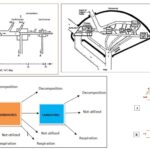Biochemistry 11 Views 1 Answers
Sourav PanLv 9April 18, 2025
What does Krebs cycle do?
What does Krebs cycle do?
Please login to save the post
Please login to submit an answer.
Sourav PanLv 9May 15, 2025
The Krebs cycle plays a central role in cellular respiration by oxidizing acetyl-CoA into carbon dioxide while capturing high-energy electrons in the form of NADH and FADH₂. These electrons drive ATP synthesis via oxidative phosphorylation. The cycle also produces a molecule of GTP (or ATP) and provides biosynthetic precursors for amino acid, nucleotide, and lipid synthesis. It functions as a metabolic hub, integrating catabolic and anabolic pathways essential for maintaining cellular energy and biochemical balance.
0
0 likes
- Share on Facebook
- Share on Twitter
- Share on LinkedIn
0 found this helpful out of 0 votes
Helpful: 0%
Helpful: 0%
Was this page helpful?




